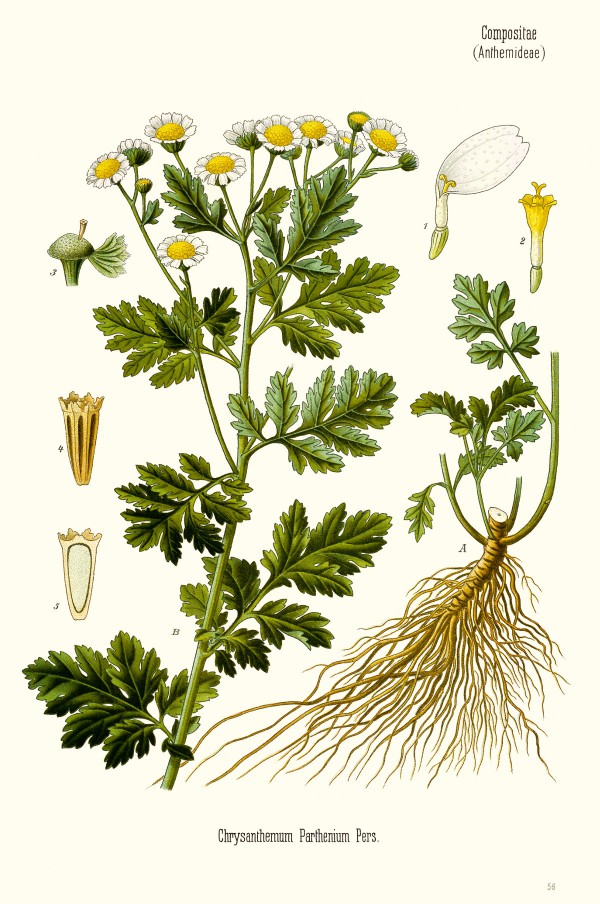Tanacetum parthenium (L.) Sch. Bip. - Matricaria parthenium L.; Chrysanthemum parthenium (L.) Bernh. - Asteraceae
feverfew, Mutterkraut
Annual or perennial herb, 20-60cm high, native to Southeast Europe, West Asia, cultivated and naturalized elsewhere; flowers daisy-like white and yellow, cultivars also with golden aromatic foliage, double flowers, or yellow flowerheads.
„Feverfew has been used as a herbal treatment to reduce fever and to treat headaches, arthritis and digestive problems, though scientific evidence does not support anything beyond a placebo effect.“ http://en.wikipedia.org/wiki/Tanacetum_parthenium
„A case of specific, delayed hypersensitivity induced by repeated contact with a wild form of feverfew (Tanacetum parthenium) is reported. In the flowers investigated the content of the responsible contact allergen parthenolide–a potent sesquiterpene lactone–appeared to be 10 times greater (0.6-0.9%) than in earlier years. Guinea pig experiments confirm the strong sensitizing potency of this Compositae species. Cross-reactions were elicited with 11 of 21 mostly Compositae plants containing chemically related sesquiterpene lactones. The strongest reactions were elicited by tansy, yarrow (milfoil), marguerite, aster, sunflower, laurel and Frullania. Structure elucidation by X-ray crystallographic analysis established the precise molecule configuration of parthenolide, although the lattice parameters of the isolated compound were not in accordance with those published in the literature.“
[Contact allergy to parthenolide in Tanacetum parthenium (L.) Schulz-Bip.(feverfew, Asteraceae) and cross-reactions to related sesquiterpene lactone containing Compositae species., Hausen, B. M., Osmundsen, P. E., Acta dermato-venereologica, Vol.63(4), 1983, 308]
„Among volatiles emitted from the aerial parts of feverfew plants and collected by the dynamic headspace technique a total of 41 compounds, mainly monoterpenes, were identified and quantified by GC and GC-MS. α-Pinene, camphene, limonene, γ-terpinene, (E)-β-ocimene, linalool, p-cymene, (E)-chrysanthenol, camphor and (E)-chrysanthenyl acetate were the predominant monoterpenes accounting for nearly 88% of the total volatiles emitted. The average total yield of volatiles emitted over 24 h was 18,160 ng/g fresh weight of leaves and flowers, corresponding to the emission of approximately 8 mg volatiles per day from one fullgrown feverfew plant. No parthenolide or other sesquiterpene lactones were detected. The present investigation does not support the theory of airborne sesquiterpene lactone-containing plant parts or of direct release of sesquiterpene lactones from living plants as the only explanations for airborne Compositae dermatitis. Potential allergens were found among the emitted monoterpenes and their importance in airborne Compositae dermatitis is discussed.“
[Airborne Compositae dermatitis: monoterpenes and no parthenolide are released from flowering Tanacetum parthenium (feverfew) plants., Christensen, L. P., Jakobsen, H. B., Paulsen, E., Hodal, L., Andersen, K. E., Archives of dermatological research, Vol.291(7-8), 1999, 425-431]
„The Compositae plant feverfew (Tanacetum parthenium) is an important sensitizer in Europe and has been suspected of causing airborne Compositae dermatitis. A previous investigation of substances emitted from feverfew plants detected no sesquiterpene lactones, however, but mainly monoterpenes. The aims of this study were to test whether feverfew-allergic patients were also sensitive to some of the above-mentioned monoterpenes and, if so, to study associations between sensitization patterns, relevance of feverfew allergy and clinical features. 17 patients with + +/+ + + reactions to feverfew and parthenolide were tested with 15 selected monoterpenes and 2 sesquiterpenes. Of the 17 persons, 13 had positive and/or doubtful positive reactions to 1 or more monoterpenes. Only 1 person was allergic to several monoterpenes. Her history of gradually worsening Compositae dermatitis culminating in a probable airborne dermatitis, mimicking photosensitivity, and the disappearance of symptoms upon removal of feverfew plants suggest monoterpenes as a possible contributing factor. Similar associations between doubtful positive monoterpene reactions and clinical patterns, fragrance/colophonium allergy and relevance of feverfew allergy were not established with certainty. In conclusion, sensitization to the sesquiterpene lactones of feverfew is not invariably accompanied by sensitization to its volatile monoterpenes. The presence of monoterpene allergy, however, may contribute to airborne Compositae dermatitis.“
[Do monoterpenes released from feverfew (Tanacetum parthenium) plants cause airborne Compositae dermatitis?, Paulsen, E., Christensen, L. P., Andersen, K. E., Contact dermatitis, Vol.47(1), 2002, 14-18]
„Compositae dermatitis confined to exposed skin has often been considered on clinical grounds to be airborne. Although anecdotal clinical and plant chemical reports suggest true airborne allergy, no proof has been procured. Feverfew (Tanacetum parthenium) is a European Compositae plant suspected of causing airborne contact allergy, and its most important allergen is the sesquiterpene lactone (SQL) parthenolide (PHL)… Feverfew-allergic patients were patch tested with extracts and fractions containing volatile monoterpenes and sesquiterpenes as well as extracts of airborne particles from flowering feverfew plants, obtained by fractionation of ether extracts, dynamic headspace and high-volume air sampler (HIVAS) technique, respectively… Among 12 feverfew-allergic patients, eight had positive patch-test reactions to a HIVAS filter extract, while two tested positive to a headspace extract. Subsequent analysis of the HIVAS extract by gas chromatography and mass spectrometry detected PHL in a concentration of 510 ng mL−1 in the HIVAS extract. Testing with a dilution series of PHL showed positive reactions down to 8·1 ng in selected patients. None of the 12 patients tested positive to monoterpenes or sesquiterpenes, whether they were oxidized or not… The clinical results have proved that some feverfew-allergic patients are sensitive to airborne particles released from the plant, and isolation of PHL from the particle-containing HIVAS extract in allergenic amounts is strong evidence of PHL as the responsible allergen.“
[Compositae dermatitis from airborne parthenolide., Paulsen, E., Christensen, L. P., Andersen, K. E., British Journal of Dermatology, Vol.156(3), 2007, 510-515]
„The essential oil of T. parthenium was obtained by hydrodistillation in three developmental stages and analyzed by gas chromatography-mass spectrometry… Twenty-nine components were identified in the essential oil; the highest amount was extracted at the flowering stage. The main component, in the flowering stage, was camphor (18.94%) and other major components were bornyl acetate (18.35%), camphene (13.74%), bornyl isovalerate (3.15%), borneol (10.93%), juniper camphor (6.23%) and β-eudesmol (2.65%).“
[Chemical composition, antibacterial activity and cytotoxicity of essential oils of Tanacetum parthenium in different developmental stages., Mohsenzadeh, F., Chehregani, A., Amiri, H., Pharmaceutical biology, Vol.49(9), 2011, 920-926]

Tanacetum parthenium as Chrysanthemum parthenium
Köhler, F.E., Medizinal Pflanzen, vol.3 t.56 (1890)
http://plantgenera.org/species.php?id_species=996549
Tanacetum parthenium; author: Rolf Marschner (2016),
www.botanische-spaziergaenge.at
